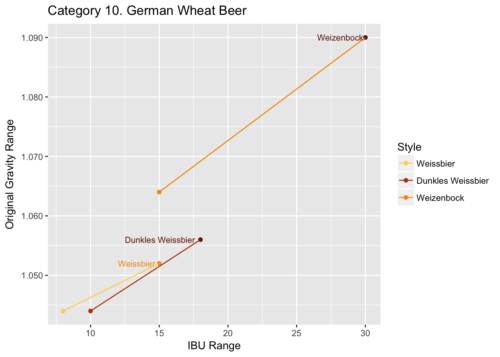BJCP Study Group: Category 10
¶ by Rob FrieselSession #19 of our BCJP study group took on Category 10. Another fun category, what with the rich history and vibrant flavors that characterize the German Wheat Beers.
Category 10. German Wheat Beer
The BJCP style guide decribes this category as: This category contains vollbier- and starkbier-strength German wheat beers without sourness, in light and dark colors.
In other words, working backward through the category name: Beer. With Wheat. Of German heritage or origin.
| 10A. Weissbier | 10B. Dunkles Weissbier | 10C. Weizenbock |
|---|---|---|
| 8 – 15 IBU | 10 – 18 IBU | 15 – 30 IBU |
| 1.044 – 1.052 O.G. | 1.044 – 1.056 O.G. | 1.064 – 1.090 O.G. |
| 1.010 – 1.014 F.G. | 1.010 – 1.014 F.G. | 1.015 – 1.022 F.G. |
| 4.3 – 5.6% ABV | 4.3 – 5.6% ABV | 6.5 – 9.0% ABV |
The unifying elements with the styles in this category converge on wheat and yeast. The wheat provides the grainy/bready malt character, as well as the proteins that help to support the big pillowy heads associated with them. The yeast inject the banana-and-clove esters and phenolics that the styles are, generally speaking, also known for. None of them are particularly hoppy, though they should have at least enough bitterness to balance. The intensity of the yeast character varies among the styles, with the stronger and maltier Weizenbock having the least. Weissbier and Dunkles Weissbier are quite similar, and differ mostly on color. Meanwhile, the Weizenbock is a significantly stronger style, with a broader allowable interpretation of colors, and more restrained yeast character.
We did a run-through of the process for a new member tonight. Otherwise we didn’t have a BJCP judge mentor to guide us so… after some preambles and banter, we got down to business.
- 10A. Weissbier. Queen City Brewery Hefeweizen. Judged; structured tasting. “I enjoyed it more than my score suggests.” That was the summary refrain from around the table. Scores were spread from 30 to 44, and mostly in the low- to mid-30s. Anyone at the table who’d had it fresh from draft at the brewery agreed: “It’s best fresh from the source.” Consensus from the judging was that it was too bitter and/or over-hopped for the style, was lacking in body, had low DMS notes, was too clear, and lacked a significant head. Just about everyone wanted more though.
- 10A. Weissbier. Schneider Weisse Original (TAP7). Not judged; no structured tasting. We tasted this one casually, as a quick comparison to the QCB Hefeweizen we’d just scored. People tended to look at this one more favorably as a “to-style” example. Off-the-cuff score guesses were high-30s to low-40s. Consensus was, by comparison, it had better body, and a better overall balance, especially with respect to its yeast products.
- 10A. Weissbier. Weihenstephaner Hefeweissbier. Not judged; no structured tasting. Again, a quicker casual tasting to do a “recent memory” comparison with the other 10A beers we’d just had. General opinion was that this had more banana qualities (i.e., more pronounced esters) than #2, and also a fuller body with more melanoidin character (better decoction handling?) The group was split on whether this one expressed more or less in the way of phenols compared to the previous two beers. For what it’s worth, I was in the camp that thought it had greater intensity phenols, though not by much.
- 10A. Weissbier. Weihenstephaner Kristallweissbier. Not judged; no structured tasting. Most group members expressed that this beer (“oddly”) expressed more phenolics than #3 — which seemed to contradict the conventional wisdom as written down in the style guide. (Not that this would be impossible — but it wasn’t what we were expecting.) As advertised, the krystal version had outstanding clarity. Its mouthfeel was much lighter than the previous three though, and we wondered if perhaps it was not decocted. Strong banana ester in the finish.
- 10C. Weizenbock. Weihenstephaner Vitus. Judged; structured tasting. The spread from the group was mostly 36 to 40 (though our outlier scores were 31 and 44). More than any other beer this night, this one stirred up the conversation. For example, I was personally looking for more phenolics (even though this style should have the lowest of the three in the category); meanwhile at least one other group member felt that the phenolics that were present completely overwhelmed the malt character. We went around about this and several other of the style’s finer points for several minutes.
- 10B. Dunkles Weissbier. Andechser Weissbier Dunkel. Not judged; no structured tasting. The second most spirited discussion of the evening. We focused the discussion on how much “richer” a 10B is compared to a 10A, but how it still wasn’t exactly rich. There were caramel notes mixed into the otherwise grainy wheat malt character, but not strong caramel. Interesting sensory profile. In retrospect, it would have been good to score one of these.
- Bonus beers. A group member smuggled home a couple of beers from the Virgin Islands for us, including a Dragon Stout (16C. Tropical Stout) and a Mackeson XXX Stout (16A. Sweet Stout). Also: Farnham 55 Blonde Russian Imperial Stout, Bent Hill Hippies in the Hills, and Frost Double Slush.
Takeaways
To be honest, not a lot of new takeaways from this study group. Summarized, they sound pretty familiar with some of the other recent groups: check your work against others (but trust your senses); be flexible in your scoring for those styles that have broader interpretations; and compare! compare! compare! within a given style to see how those different interpretations might show up.



Leave a Reply